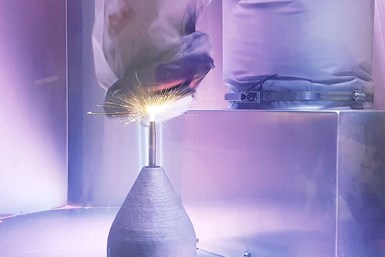Spee3D Opens US-Based Manufacturing Facility and Applications Center
The U.S. location enables Spee3D to closely collaborate more readily with North American customers, including the U.S. Department of Defense.
Spee3D’s Phaser Nozzle is an ultrahigh-energy nozzle designed to work with the company’s cold spray metal 3D printers, a wide range of hard-phase materials and with a significant increase in deposition velocity. Source: Spee3D
Spee3D, a metal additive manufacturing (AM) company, has opened its first U.S.-based manufacturing facility and applications center at the John Olson Advanced Manufacturing Center at the University of New Hampshire (UNH). The new location will enable Spee3D to collaborate more closely with clients in the United States, including the U.S. Department of Defense
Spee3D will manufacture printers at the new facility, while maintaining its manufacturing headquarters in Melbourne, Australia. The company will also staff an applications center and work with customers to identify new applications and tailor solutions based on their specific needs. Additionally, Spee3D will leverage UNH’s resources, facilities and talent pool to drive AM innovation and adoption, while providing technical support for existing and future advanced 3D printing initiatives.
“Establishing our first U.S.-based location at the Olson Center brings together a world-class manufacturing center at UNH with Spee3D’s leading cold spray additive manufacturing technology to a region known for its innovation and advancements,” says Byron Kennedy, Spee3D CEO. “Although we are an Australian company, we have partners worldwide and a strong presence in America, so it made perfect sense to expand our footprint to address the needs of our partners.”
Spee3D's new location is strategically located at one of the nation’s most prominent tech corridors, offering unique opportunities to participate in joint collaborative projects and programs with nearby research, engineering and repair/overhaul facilities. These include the U.S. Department of Defense, the Portsmouth Naval Shipyard (NH), Bath Iron Works (ME), the Army Natick Soldier Research Center (MA), the U.S. Army Research Laboratory (MA), the Naval Underwater Warfare Center (RI) and the Raytheon Technology Research Center (CT).
“UNH’s partnership with Spee3D underscores the vital role that academic and industry collaboration can play in fostering innovation and cutting-edge research,” says Marian McCord, senior vice provost for research, economic engagement and outreach at UNH. “We are proud to be an integral part of the state’s innovation ecosystem by providing facilities, a skilled workforce, and access to a robust business and research community. We are thrilled Spee3D has chosen UNH’s John Olson Advanced Manufacturing Center as its first U.S. manufacturing location and look forward to establishing N.H., and UNH, as a global destination for industry.”
Related Content
-
Additive Manufacturing for Defense: Targeting Qualification
Targeting qualification in additive manufacturing for the defense industry means ensuring repeatability as well as reliability as there is much at stake, including human lives. Certain requirements therefore must be met by weapons systems used by the defense industry.
-
For Coast Guard, AM Adoption Begins With “MacGyver-ish” Crew Members Who Are Using 3D Printing Already
AM suits the Coast Guard’s culture of shipboard problem-solving, says Surface Fleet AM lead. Here is how 3D printers on ships promise to deliver not just substantial cost savings but also an aid to crew capabilities and morale.
-
This Year I Have Seen a Lot of AM for the Military — What Is Going On?
Audience members have similar questions. What is the Department of Defense’s interest in making hardware via 3D printing over conventional methods? Here are three manufacturing concerns that are particular to the military.












